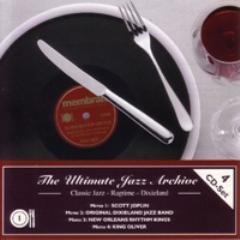The Ultimate Jazz Archive CD02 - Original Dixieland Jazz Band 1917-1921 (2005)
The Ultimate Jazz Archive – CD02 - Original Dixieland Jazz Band 1917-1921 (2005)

01.Livery Stable Blues 02.Dixie Jass Band One Step 03.At The Jazz Band Ball 04.Ostrich Walk 05.Skeleton Jangle 06.Tiger Rag 07.Bluin’ The Blues 08.Fidgety Feet 09.Sensation Rag 10.Mournin’ Blues 11.Clarinet Marmalade Blues 12.Lazy Daddy 13.Margie 14.Palestreena 15.Broadway Rose 16.Sweet Mama (Papa’s Getting Mad) 17.Home Again Blues 18.Crazy Blues
The first jazz group to ever record, Original Dixieland Jazz Band made history in 1917. They were not the first group to ever play jazz (Buddy Bolden had preceded them by 22 years!), nor was this White quintet necessarily the best band of the time, but during 1917-1923 (particularly in their earliest years) they did a great deal to popularize jazz. The musicians learned about jazz from their fellow New Orleans players (including King Oliver) but happened to get their big break first. In 1916, drummer Johnny Stein, cornetist Nick LaRocca, trombonist Eddie Edwards, pianist Henry Ragas, and clarinetist Alcide "Yellow" Nunez played together in Chicago. With Tony Sbarbaro replacing Stein and Larry Shields taking over for Nunez, the band was booked at Resenweber's restaurant in New York in early 1917. Their exuberant music (which stuck exclusively to ensembles with the only solos being short breaks) caused a major sensation. Columbia recorded ODJB playing "Darktown Strutters Ball" and "Indiana," but was afraid to put out the records. Victor stepped in and recorded the group playing the novelty "Livery Stable Blues" (which found the horns imitating barnyard animals) and "Dixie Jass Band One-Step" and quickly released the music; "Livery Stable Blues" was a huge hit that really launched the jazz age. During the next few years ODJB would introduce such future standards as "Tiger Rag," "At the Jazz Band Ball," "Fidgety Feet," "Sensation," "Clarinet Marmalade," "Margie," "Jazz Me Blues," and "Royal Garden Blues." The group (with J. Russel Robinson taking the place of Ragas, who died in the 1919 flu epidemic, and trombonist Emile Christian filling in for Edwards) visited London during 1919-1920 and they once again caused quite a stir, introducing jazz to Europe. However upon their return to the U.S., ODJB was considered a bit out of fashion after the rise of Paul Whiteman and in 1922 New Orleans Rhythm Kings (a far superior group). By 1923 when many of the first Black jazz giants finally were recorded, ODJB was thought of as a historical band and due to internal dissension they soon broke up. In 1936 LaRocca, Shields, Edwards, Robinson, and Sbarbaro (the latter the only musician to have a full-time career by then) had a reunion and did a few final recordings together before LaRocca permanently retired. Although the cornetist's arrogant claims that ODJB had invented jazz are exaggerated and tinged with racism, Original Dixieland Jazz Band did make a strong contribution to early jazz (most groups that recorded during 1918-1921 emulated their style), helped supply the repertoire of many later Dixieland bands, and were an influence on Bix Beiderbecke and Red Nichols. --Scott Yanow, Rovi
Last Updated (Thursday, 27 December 2012 18:04)








